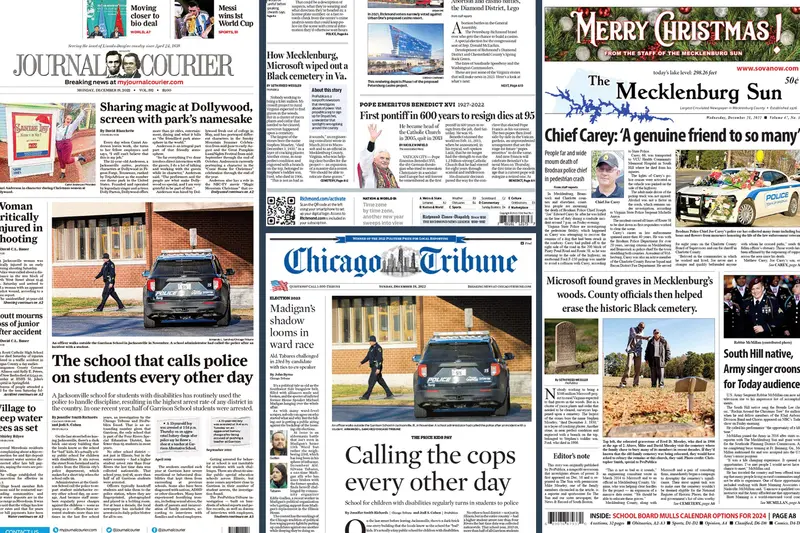What Does News Articles Do?
What Does News Articles Do?
Blog Article
Indicators on News Articles You Should Know
Table of ContentsFacts About News Articles RevealedA Biased View of News ArticlesA Biased View of News ArticlesThings about News ArticlesThe Basic Principles Of News Articles
Excellent understanding of different subjects provides trainees an one-upmanship over their peers. Also though electronic and social networks are readily available, we must not forget just how essential it is to read the newspapers. Parents need to try and inculcate the habit of reviewing a newspaper as an everyday routine to continue the tradition of the adored print tool.Newspaper article also contain at the very least among the adhering to important qualities about the intended audience: proximity, prominence, timeliness, human interest, anomaly, or effect. The associated term journalese is often made use of, generally pejoratively, to refer to news-style writing. One more is headlinese. Newspapers generally follow an expository writing design.
Within these limitations, information tales additionally intend to be detailed. Amongst the larger and more highly regarded newspapers, justness and balance is a major variable in offering info.
Newspapers with an international target market, for instance, tend to make use of an extra formal style of creating. The particular choices made by an information outlet's editor or editorial board are usually accumulated in a design guide; usual style overviews include the and the United States News Style Book. The main objectives of news writing can be summed up by the ABCs of journalism: accuracy, brevity, and quality.
What Does News Articles Mean?
As a guideline, journalists will certainly not use a long word when a short one will do. They make use of subject-verb-object building and brilliant, active prose (see Grammar). They use anecdotes, instances and allegories, and they rarely rely on generalizations or abstract concepts. News writers attempt to prevent utilizing the exact same word greater than as soon as in a paragraph (sometimes called an "echo" or "word mirror").
However, headings sometimes leave out the subject (e.g., "Leaps From Boat, Catches in Wheel") or verb (e.g., "Cat lady fortunate"). A subhead (likewise subhed, sub-headline, subheading, subtitle, deck or dek) can be either a secondary title under the main heading, or the heading of a subsection of the article. It is a heading that precedes the major message, or a group of paragraphs of the major text.

Extra billboards of any of these types might appear later in the article (particularly on succeeding pages) to lure further reading. Such billboards are likewise made use of as pointers to the post in various other sections of the publication or website, or as advertisements for the item in various other publication or websites. Normal framework with title, lead paragraph (recap in strong), other paragraphs (details) and get in touch with information.

Example of a hard-lead paragraph NASA is suggesting an additional space task. The firm's budget plan demand, introduced today, consisted of a plan to send out another goal to the Moon. This time the firm wishes to establish a lasting facility as a jumping-off point for various other space adventures. The budget requests around $10 billion for the task.
The NASA news came as the agency asked for $10 billion Going Here of appropriations for the project. An "off-lead" is the 2nd essential front web page news of the day. The off-lead shows up either in the top left corner, or straight listed below the lead on the right. To "bury the lead" is to begin the post with history information or information of second significance to the viewers, requiring them to learn more deeply right into an article than they must have to in order to uncover the vital points.
News Articles - Questions
Typical usage is that one or 2 sentences each develop their very own paragraph. Reporters typically explain the organization or framework of a newspaper article as an inverted pyramid. The vital and most interesting elements of a story are placed at the start, with sustaining information following in order of reducing significance.
It enables people to explore a topic to only the depth that their curiosity takes them, and without the charge of information or nuances that they can consider unnecessary, but still making that details readily available to more interested viewers. The inverted pyramid click over here structure also allows write-ups to be cut to any type of approximate size throughout design, to suit the space readily available.
Some writers start their tales with the "1-2-3 lead", yet there are numerous kinds of lead readily available. get redirected here A kicker can refer to numerous things: The last story in the news broadcast; a "satisfied" story to end the program.
Longer articles, such as publication cover articles and the pieces that lead the inside areas of a newspaper, are recognized as. Feature stories differ from straight news in a number of ways. Foremost is the lack of a straight-news lead, a lot of the moment. Rather than offering the significance of a tale up front, function writers may attempt to tempt visitors in.
Excitement About News Articles
A feature's very first paragraphs often associate an appealing minute or occasion, as in an "unscientific lead". From the particulars of a person or episode, its view rapidly expands to generalities concerning the tale's subject.

The Editor's Tool kit: A Reference Guide for Beginners and Professionals (2001) Allan M. Siegal and William G. Connolly. The New York Times Guidebook of Design and Usage: The Authorities Design Overview Used by the Writers and Editors of the Globe's Most Reliable Paper (2002) M. L. Stein, Susan Paterno, and R.
Report this page